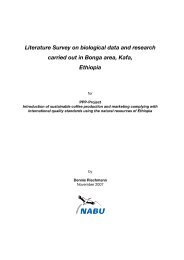Flora Biodiversity Assessment in Bonga, Boginda and Mankira Forest
Flora Biodiversity Assessment in Bonga, Boginda and Mankira Forest
Flora Biodiversity Assessment in Bonga, Boginda and Mankira Forest
You also want an ePaper? Increase the reach of your titles
YUMPU automatically turns print PDFs into web optimized ePapers that Google loves.
most important species (>=10cm dbh) <strong>in</strong> each forest area which have IVI greater than 10<br />
are presented <strong>in</strong> the follow<strong>in</strong>g Table (Table 11).<br />
Table 11. Important species <strong>in</strong> <strong>Mankira</strong>, <strong>Bonga</strong> <strong>and</strong> Bog<strong>in</strong>da<br />
<strong>Mankira</strong> <strong>Bonga</strong> Bog<strong>in</strong>da<br />
Croton macrostachyus (26) Draceaena steudneri (17) Chionanthus mildbraedii (17)<br />
Phonix recl<strong>in</strong>ata (21) Schefflera volkensii (15) Milletia ferrug<strong>in</strong>ea (17)<br />
Sapium ellepticum (21) Schefflera abyss<strong>in</strong>ica (14) Prunus Africana (15)<br />
Celtis africana (13) Milletia ferrug<strong>in</strong>ea (10) Olea welwitschii (14)<br />
Vepris da<strong>in</strong>elli (13) Olea welwitschii (10) Macaranga capensis (13)<br />
Cordia africana (12) Schefflera abyss<strong>in</strong>ica (12)<br />
Cachno (10) L<strong>and</strong>olphia owerensis (12)<br />
Diospyrose abyss<strong>in</strong>ica (10) Syzygium gu<strong>in</strong>eense (12)<br />
Milletia ferrug<strong>in</strong>ea (10) Vepris da<strong>in</strong>elli (10)<br />
Chionanthus mildbraedii (10) Allophyllus abyss<strong>in</strong>icus (10)<br />
Sapium ellepticum (10)<br />
Pouteria adolfi-friederici (10)<br />
Surpris<strong>in</strong>gly, except for Dracaena afromontana, D. steudneri <strong>and</strong> Bersama abyss<strong>in</strong>ica,<br />
all species <strong>in</strong>dicated <strong>in</strong> the Table 10 are expressed as important species by Getachew<br />
Berhane <strong>and</strong> Yoseph Assefa <strong>in</strong> IBC, 2002. Species that are not characterized as important<br />
but found to be important <strong>in</strong> this study are Syzygium gu<strong>in</strong>eense, Allophyllus abyss<strong>in</strong>icus,<br />
Sapium ellepticum, L<strong>and</strong>olphia owerensis <strong>and</strong> Olea welwitschii.<br />
In general, with regard to forest <strong>in</strong> the study area, it is hardly possible to separate or to<br />
map dist<strong>in</strong>ctively different communities as most of the tree species are overlapp<strong>in</strong>g.<br />
Community type may be classified based on three systems viz. physiognomic, floristic<br />
<strong>and</strong> dynamic system 10 . Despite the fact that we talk about one community type, as Friis<br />
(1994) categorized it - Afromontane Ra<strong>in</strong> <strong>Forest</strong>- for this particular site floristic<br />
classification is chosen <strong>and</strong> “association” where nam<strong>in</strong>g is made based on the basis of<br />
common dom<strong>in</strong>ant species <strong>in</strong> several st<strong>and</strong>s (<strong>Mankira</strong>, <strong>Bonga</strong> <strong>and</strong> Bog<strong>in</strong>da <strong>in</strong> this case).<br />
Accord<strong>in</strong>gly, <strong>in</strong> <strong>Bonga</strong> forest Draceaena steudneri <strong>and</strong> Schefflera volkensii; <strong>in</strong> <strong>Mankira</strong><br />
forest Croton macrostachyus, Phonix recl<strong>in</strong>ata <strong>and</strong> Vepris da<strong>in</strong>elli; <strong>and</strong> <strong>in</strong> Bog<strong>in</strong>da<br />
Milletia ferrug<strong>in</strong>ea, Chionanthus mildbraedii <strong>and</strong> Macaranga capensis are found to be<br />
10 Based on Lecture note on “General Ecology”, Wondogenet College of <strong>Forest</strong>ry<br />
55



